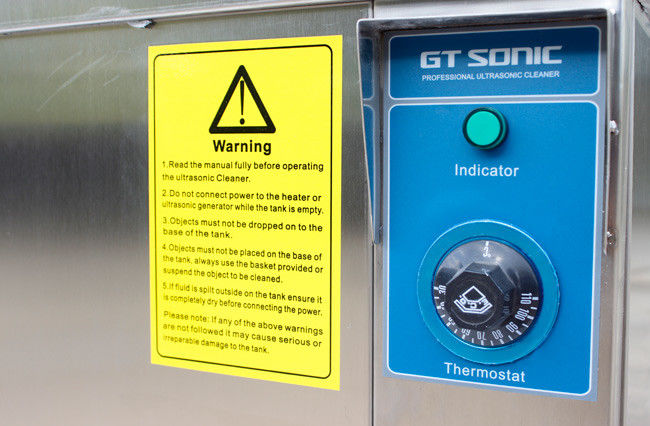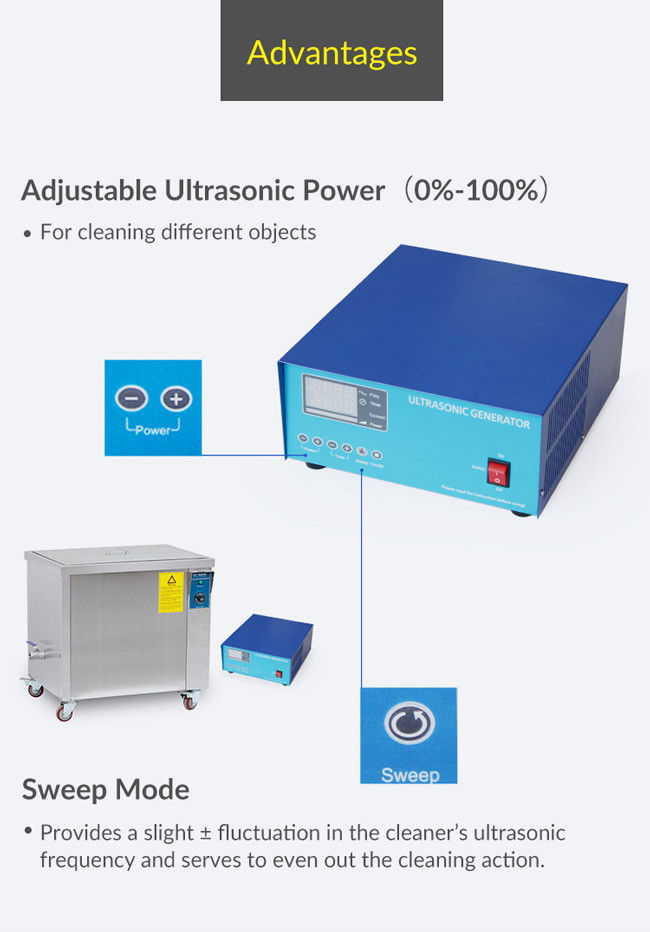
| Brand Name: | GT SONIC |
| Model Number: | VGT-1030S |
| MOQ: | 1 pc |
| Price: | Negotiable |
| Packaging Details: | Standard packing : pearl wood + carton packing |
| Payment Terms: | L/C, T/T |
Ultrasonic Cleaner Features:
1. 2.0 thickness stainless steel tank for acid-proof, anti-corrosive.
2. Ultrasonic power can be adjusted from 0-100%.
3. Temperature control: 30-110 °C adjustable.
4. Industrial grade for 24 hours of continuous working.
5. Advanced generator, sweep frequency, better effect, high quality.
6. Ultrasonic frequency optional: 28kHz or 40KHz.
7. Steady and durable performance.
8. With free lid and stainless steel SUS304 mesh basket.
SPECIFICATION:
| Model | VGT-1012S | VGT-1018S | VGT-1024S | VGT-1030S | VGT-1036S | VGT-1042S |
| Volume Size (L) | 40L | 65L | 96L | 117L | 157L | 206L |
| Tank Internal Dimension (mm) | 400×300×300 | 500x350x360 | 600x400x400 | 650x450x400 | 700x500x450 | 750x550x500 |
| Operation Frequency (kHz) | 28/40 | 28/40 | 28/40 | 28/40 | 28/40 | 28/40 |
| Ultrasonic Power (w) | 720 | 1080 | 1440 | 1800 | 2160 | 2520 |
| Heating Temperature | 30-110 °C | 30-110 °C | 30-110 °C | 30-110 °C | 30-110 °C | 30-110 °C |
| Over heat protection | Yes | Yes | Yes | Yes | Yes | Yes |
| Timer |
0-60 minutes /untimed |
0-60 minutes /untimed |
0-60 minutes /untimed |
0-60 minutes /untimed |
0-60 minutes /untimed |
0-60 minutes /untimed |
| Drainage Valve | Yes | Yes | Yes | Yes | Yes | Yes |
| Universal wheel | Yes | Yes | Yes | Yes | Yes | Yes |
| Cover | Yes | Yes | Yes | Yes | Yes | Yes |
| Basket | Yes | Yes | Yes | Yes | Yes | Yes |
What is Ultrasonic?
Ultrasonic refers to sound waves that have a frequency higher than the upper limit of human hearing, which is generally considered to be around 20 kilohertz (kHz). In other words, ultrasonic waves are sound waves that vibrate at a frequency greater than 20,000 vibrations per second.
Ultrasonic waves are produced using a device called an ultrasonic transducer, which converts electrical energy into high-frequency mechanical vibrations. These vibrations are then transmitted through a medium, such as air or water, and can be used for a variety of applications.
One of the most common applications of ultrasonic waves is in ultrasonic cleaning, where high-frequency sound waves are used to create microscopic bubbles in a cleaning solution. These bubbles then collapse upon contact with the surface being cleaned, generating a powerful scrubbing effect that can remove even the most stubborn stains and debris.
Ultrasonic waves also have a range of other applications, such as in medical imaging, non-destructive testing, and industrial processing. In medical imaging, ultrasonic waves are used to create images of internal organs and tissues, while in non-destructive testing, they are used to detect flaws in materials and structures. In industrial processing, ultrasonic waves can be used for welding, cutting, and cleaning, among other applications.
What is De-gassing?
Degassing refers to the process of removing dissolved gases from liquids or solids. When liquids or solids are exposed to atmospheric pressure or changes in temperature, gases such as oxygen, nitrogen, and carbon dioxide can become dissolved in the material. Over time, these dissolved gases can create problems such as corrosion, foaming, and reduced performance.
The degassing process involves exposing the material to a reduced-pressure environment, such as a vacuum chamber or a degassing unit. The reduced pressure causes the dissolved gases to come out of the solution and escape from the material, usually in the form of bubbles. The bubbles are then removed from the material, either by vacuuming them away or allowing them to rise to the surface and escape.
There are many applications for degassing, including in the production of electronic components, where the presence of dissolved gases can interfere with the performance of sensitive components such as microchips and circuit boards. Degassing is also used in the production of pharmaceuticals, where the presence of dissolved gases can affect the quality and purity of the final product. Additionally, degassing is used in the production of food and beverages, where dissolved gases can affect the taste, appearance, and texture of the final product.
PRODUCT DETAILS:



| Brand Name: | GT SONIC |
| Model Number: | VGT-1030S |
| MOQ: | 1 pc |
| Price: | Negotiable |
| Packaging Details: | Standard packing : pearl wood + carton packing |
| Payment Terms: | L/C, T/T |
Ultrasonic Cleaner Features:
1. 2.0 thickness stainless steel tank for acid-proof, anti-corrosive.
2. Ultrasonic power can be adjusted from 0-100%.
3. Temperature control: 30-110 °C adjustable.
4. Industrial grade for 24 hours of continuous working.
5. Advanced generator, sweep frequency, better effect, high quality.
6. Ultrasonic frequency optional: 28kHz or 40KHz.
7. Steady and durable performance.
8. With free lid and stainless steel SUS304 mesh basket.
SPECIFICATION:
| Model | VGT-1012S | VGT-1018S | VGT-1024S | VGT-1030S | VGT-1036S | VGT-1042S |
| Volume Size (L) | 40L | 65L | 96L | 117L | 157L | 206L |
| Tank Internal Dimension (mm) | 400×300×300 | 500x350x360 | 600x400x400 | 650x450x400 | 700x500x450 | 750x550x500 |
| Operation Frequency (kHz) | 28/40 | 28/40 | 28/40 | 28/40 | 28/40 | 28/40 |
| Ultrasonic Power (w) | 720 | 1080 | 1440 | 1800 | 2160 | 2520 |
| Heating Temperature | 30-110 °C | 30-110 °C | 30-110 °C | 30-110 °C | 30-110 °C | 30-110 °C |
| Over heat protection | Yes | Yes | Yes | Yes | Yes | Yes |
| Timer |
0-60 minutes /untimed |
0-60 minutes /untimed |
0-60 minutes /untimed |
0-60 minutes /untimed |
0-60 minutes /untimed |
0-60 minutes /untimed |
| Drainage Valve | Yes | Yes | Yes | Yes | Yes | Yes |
| Universal wheel | Yes | Yes | Yes | Yes | Yes | Yes |
| Cover | Yes | Yes | Yes | Yes | Yes | Yes |
| Basket | Yes | Yes | Yes | Yes | Yes | Yes |
What is Ultrasonic?
Ultrasonic refers to sound waves that have a frequency higher than the upper limit of human hearing, which is generally considered to be around 20 kilohertz (kHz). In other words, ultrasonic waves are sound waves that vibrate at a frequency greater than 20,000 vibrations per second.
Ultrasonic waves are produced using a device called an ultrasonic transducer, which converts electrical energy into high-frequency mechanical vibrations. These vibrations are then transmitted through a medium, such as air or water, and can be used for a variety of applications.
One of the most common applications of ultrasonic waves is in ultrasonic cleaning, where high-frequency sound waves are used to create microscopic bubbles in a cleaning solution. These bubbles then collapse upon contact with the surface being cleaned, generating a powerful scrubbing effect that can remove even the most stubborn stains and debris.
Ultrasonic waves also have a range of other applications, such as in medical imaging, non-destructive testing, and industrial processing. In medical imaging, ultrasonic waves are used to create images of internal organs and tissues, while in non-destructive testing, they are used to detect flaws in materials and structures. In industrial processing, ultrasonic waves can be used for welding, cutting, and cleaning, among other applications.
What is De-gassing?
Degassing refers to the process of removing dissolved gases from liquids or solids. When liquids or solids are exposed to atmospheric pressure or changes in temperature, gases such as oxygen, nitrogen, and carbon dioxide can become dissolved in the material. Over time, these dissolved gases can create problems such as corrosion, foaming, and reduced performance.
The degassing process involves exposing the material to a reduced-pressure environment, such as a vacuum chamber or a degassing unit. The reduced pressure causes the dissolved gases to come out of the solution and escape from the material, usually in the form of bubbles. The bubbles are then removed from the material, either by vacuuming them away or allowing them to rise to the surface and escape.
There are many applications for degassing, including in the production of electronic components, where the presence of dissolved gases can interfere with the performance of sensitive components such as microchips and circuit boards. Degassing is also used in the production of pharmaceuticals, where the presence of dissolved gases can affect the quality and purity of the final product. Additionally, degassing is used in the production of food and beverages, where dissolved gases can affect the taste, appearance, and texture of the final product.
PRODUCT DETAILS:


